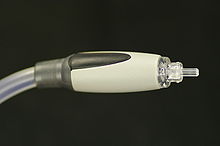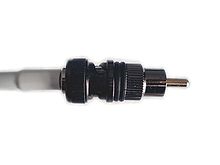- S/PDIF
-
 TOSLINK connector (JIS F05).
TOSLINK connector (JIS F05).
S/PDIF is a digital audio interconnect used in consumer audio equipment over relatively short distances. The signal is transmitted over either a coaxial cable with RCA connectors or a fiber optic cable with TOSLINK connectors. S/PDIF interconnects components in home theaters and other digital high fidelity systems. S/PDIF is based on the professional AES3 interconnect standard.[1] S/PDIF can carry two channels of PCM audio or a multi-channel compressed surround sound format such as Dolby Digital or DTS.
S/PDIF is a data link layer protocol and a set of physical layer specifications for carrying digital audio signals between devices and components over either optical or electrical cable. The name stands for Sony/Philips Digital Interconnect Format (more commonly known as Sony Philips Digital Interface), Sony and Philips being the primary designers of S/PDIF. S/PDIF is standardized in IEC 60958 as IEC 60958 type II (IEC 958 before 1998[2]).
Contents
Applications
A common use for the S/PDIF interface is to carry compressed digital audio as defined by the standard IEC 61937. This mode is used to connect the output of a DVD player to a home-theater receiver that supports Dolby Digital or DTS surround sound. Another common use is to carry two channels of uncompressed digital audio from a CD player to a receiver. This specification also allows for the coupling of personal computer digital sound (if equipped) via optical or coax to Dolby or DTS capable receivers. This only supports stereo sound, unless the personal computer supports a surround sound encoding such as Dolby Digital Live or DTS Connect
Hardware specifications
S/PDIF was developed at the same time as the main standard, AES3, used to interconnect professional audio equipment in the professional audio field. This resulted from the desire of the various standards committees to have at least sufficient similarities between the two interfaces to allow the use of the same, or very similar, designs for interfacing ICs.[3] S/PDIF remained almost identical at the protocol level (consumer S/PDIF provides for copy protection, whereas professional interfaces do not), but changed the physical connectors from XLR to either electrical coaxial cable (with RCA connectors) or optical fibre (TOSLINK; i.e., F05 or EIAJ Optical), both of which cost less. The RCA connectors are typically color-coded orange to differentiate from other RCA connector uses such as composite video. The cable was also changed from 110 Ω balanced twisted pair to the already far more common (and therefore compatible and inexpensive) 75 Ω coaxial cable, using RCA jacks instead of the BNC connector, which is more common in commercial applications. S/PDIF is a consumer version of the AES3 format.
Signals transmitted over consumer-grade TOSLINK connections are identical in content to those transmitted over coaxial S/PDIF connectors, though they commonly exhibit higher jitter. (See Limitations below.)
Main differences between AES3 and S/PDIF[4] AES3 balanced AES3 unbalanced S/PDIF Cabling 110-ohm STP 75-ohm coaxial 75-ohm coaxial or fiber Connector 3-pin XLR BNC RCA or TOSLINK Output level 2 to 7 V peak to peak 1 to 1.2 V peak to peak 0.5 to 0.6 V peak to peak Min Input level 0.2 V 0.32 V 0.2 V Max distance 100m 1000m 10m Modulation Biphase mark code Biphase mark code Biphase mark code Subcode information ASCII ID text ASCII ID text SCMS copy protection info Max. Resolution 24 bits 24 bits 20 bits (24 bits optional) Protocol specifications
S/PDIF is used to transmit digital signals of a number of formats, the most common being the 48 kHz sample rate format (used in DAT) and the 44.1 kHz format, used in CD audio. In order to support both systems, as well as others that might be needed, the format has no defined data rate. Instead, the data is sent using biphase mark code, which has either one or two transitions for every bit, allowing the original word clock to be extracted from the signal itself.
S/PDIF is meant to be used for transmitting 20-bit audio data streams plus other related information. To transmit sources with less than 20 bits of sample accuracy, the superfluous bits will be set to zero. S/PDIF can also transport 24-bit samples by way of four extra bits; however, not all equipment supports this, and these extra bits may be ignored.
Channel status bit
Since the low-level protocol is almost the same, it is described in the AES3 article. The only difference is in the "channel status bit".
Control word components Bit num. If not set means: If set means: 0 Consumer (S/PDIF) Professional (AES3)
(Changes meaning of control word)1 Normal Compressed data 2 Copy restrict Copy permit 3 2 channels 4 channels 4 — — 5 No pre-emphasis Pre-emphasis 6–7 Mode, defines subsequent bytes, always zero 8–14 Audio source category (general, CD-DA, DVD, etc.) 15 L-bit, original or copy (see text) There is one channel status bit in each subframe, making 384 bits in each audio block. This means that there are 384/8 = 48 bytes available in each audio block. The meaning of the channel status bits is completely different between AES3 and S/PDIF.
For S/PDIF, the 192-bit block for each channel is divided into 12 words of 16 bits each. The first 6 bits of the first word are a control code. The meaning of its bits are shown in the accompanying table.
Bits 8–14 of the control code are a 7-bit category code indicating the type of source equipment, and bit 15 is the "L-bit", which (for most category codes) indicates whether copy-restricted audio is original (may be copied once) or a copy (does not allow recording again). The L-bit is only used if bit 2 is zero, meaning copy-restricted audio. The L-bit polarity depends on the category, with recording allowed if it is 1 for DVD-R and DVR-RW, but 0 for CD-R, CD-RW, and DVD. For plain CD-DA (ordinary nonrecordable CDs), the L-bit is not defined, and recording is prevented by alternating bit 2 at a rate of 4–10 Hz.
Limitations
The receiver does not control the data rate, so it must avoid bit slip by synchronising its conversion with the source clock. This means that S/PDIF cannot fully decouple the final signal from influence by the analogue characteristics of the source or the interconnect, even though the digital audio data can normally be transmitted without loss. The source clock may carry inherent jitter or wander, and noise or distortion introduced in the data cable may further influence the process of clock recovery.[5][6][7] If the DAC does not have a stable clock reference then noise will be introduced into the resulting analogue signal. However, receivers can implement various strategies which limit this influence.[7][8]
TOSLINK cables do not work well (and may even suffer permanent damage) if tightly bent or squashed by, say, a misplaced foot. Their high light-signal attenuation limits their effective range to 6.1 metres (20 ft) or so. On the other hand, TOSLINK cables are not susceptible to ground loops and RF interference, as coaxial cables are.[9]
S/PDIF lacks flow control and retransmission facilities, which limits its usefulness in data communications applications.
See also
References
- ^ "SoundSystem SixPack 5.1+ True 6 Channel + Digital In & out - Stuff Worth Knowing" (PDF). TerraTec. 5 July 2001. p. 43. ftp://ftp.terratec.de/Audio/SiXPack5.1+/Manual/SiXPack5.1+_Manual_GB.pdf. Retrieved 18 January 2011.
- ^ "Sound card". kioskea.net. Kioskea Network. http://en.kioskea.net/contents/pc/carte-son.php3. Retrieved 2010-08-04. "The main components of a sound card are: [...] An SPDIF digital output (Sony Philips Digital Interface, also known as S/PDIF or S-PDIF or IEC 958 or IEC 60958 since 1998). This is an output line which sends digitised audio data to a digital amplifier using a coaxial cable with RCA connectors at the ends."
- ^ Finger, Robert A. 1992 'AES3-1992: The RevisedTwo-ChannelDigital Audio Interface', J.AudioEng.Soc.,Vol.40,No.3, 1992 March, p108
- ^ "RaneNote INTERFACING AES3 & S/PDIF" (PDF). Rane Corp.. 2010. p. 2. http://www.nu9n.com/images/AES3-SPDIF-notes.pdf. Retrieved 18 January 2011.
- ^ Giorgio Pozzoli. "DIGITabilis: crash course on digital audio interfaces" tnt-audio.com.
- ^ Chris Dunn, Malcolm J. Hawksford. "Is the AES/EBU/SPDIF Digital Audio Interface Flawed?" AES Convention 93, paper 3360.
- ^ a b Norman Tracy. "On Jitter, the S/PDIF Standard, and Audio DACs."
- ^ Paul Lesso. "A High Performance S/PDIF Receiver" AES Convention 121, paper 6948.
- ^ Joseph D. Cornwall (December 31, 2004). "Understanding Digital Interconnects". Audioholics.com. http://www.audioholics.com/education/cables/understanding-digital-interconnects. Retrieved 2007-07-12.
External links
Audio and video connectors Single conductor audio Analog audio Digital audio Video Audio and Video Visual charts Audio and Video Interfaces and Connectors Audio Only AnalogInterface: PC System Design Guide Connectors: TRS 3.5mmDigitalVideo Only AnalogDigital and
AnalogVideo and Audio DigitalInterface: HDMI Connectors: HDMI connector • Interface: DisplayPort Connectors: DisplayPort connectorCategories:- Audio engineering
- IEC standards
- Digital audio
- Computer hardware standards
Wikimedia Foundation. 2010.

